trailer LEXUS RC300 2021 Owners Manual
[x] Cancel search | Manufacturer: LEXUS, Model Year: 2021, Model line: RC300, Model: LEXUS RC300 2021Pages: 400, PDF Size: 7.9 MB
Page 2 of 400
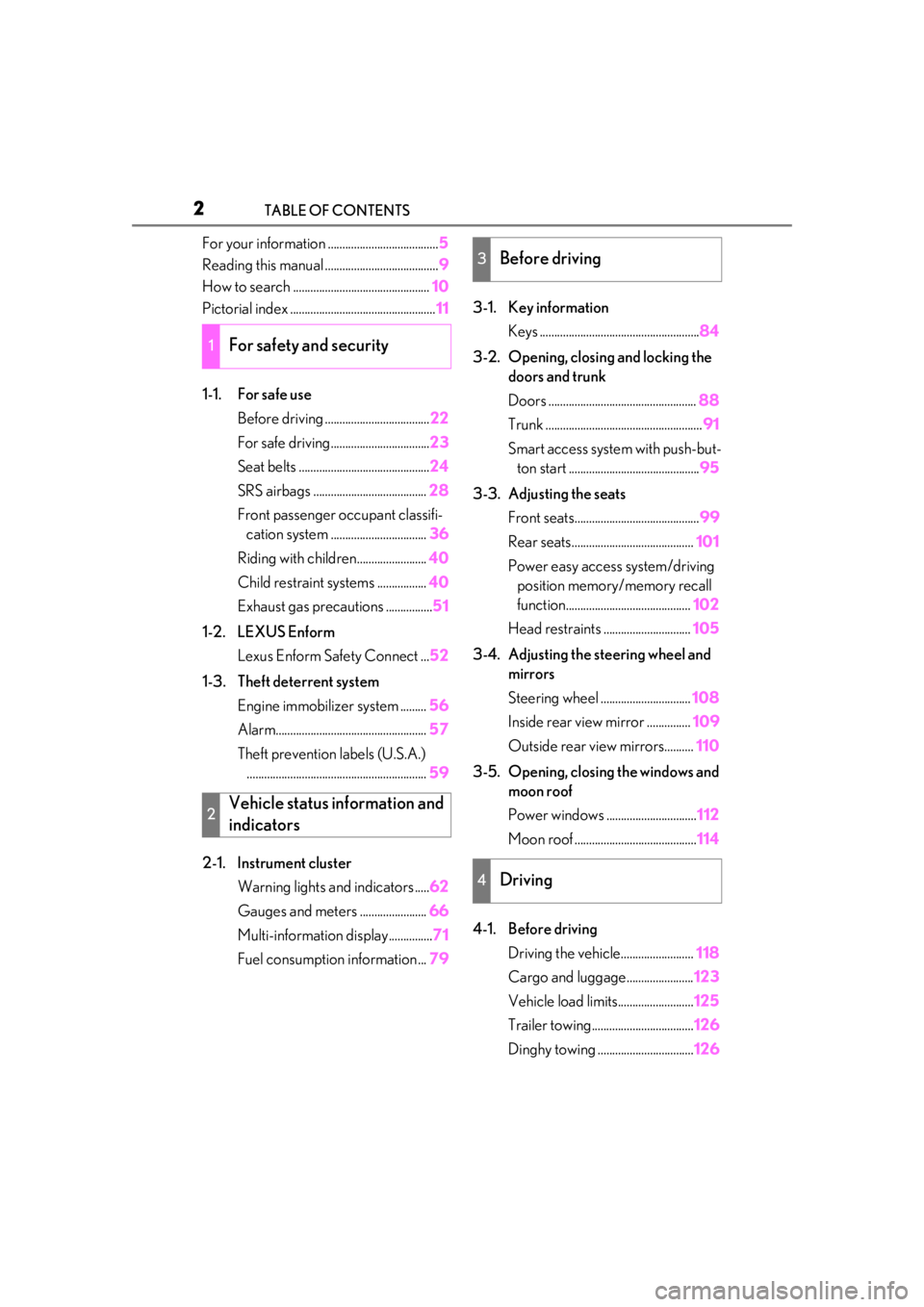
2TABLE OF CONTENTS
For your information ......................................5
Reading this manual ....................................... 9
How to search ............................................... 10
Pictorial index .................................................. 11
1-1. For safe use Before driving .................................... 22
For safe driving.................................. 23
Seat belts ............................................. 24
SRS airbags ....................................... 28
Front passenger occupant classifi- cation system ................................. 36
Riding with children........................ 40
Child restraint systems ................. 40
Exhaust gas precautions ................ 51
1-2. LEXUS Enform Lexus Enform Safety Connect ... 52
1-3. Theft deterrent system Engine immobilizer system ......... 56
Alarm.................................................... 57
Theft prevention labels (U.S.A.) .............................................................. 59
2-1. Instrument cluster Warning lights and indicators ..... 62
Gauges and meters ....................... 66
Multi-information display............... 71
Fuel consumption information ... 793-1. Key information
Keys ....................................................... 84
3-2. Opening, closing and locking the doors and trunk
Doors ................................................... 88
Trunk ...................................................... 91
Smart access system with push-but- ton start ............................................. 95
3-3. Adjusting the seats Front seats........................................... 99
Rear seats.......................................... 101
Power easy access system/driving position memory/memory recall
function........................................... 102
Head restraints .............................. 105
3-4. Adjusting the steering wheel and mirrors
Steering wheel ............................... 108
Inside rear view mirror ............... 109
Outside rear view mirrors.......... 110
3-5. Opening, closing the windows and moon roof
Power windows ............................... 112
Moon roof .......................................... 114
4-1. Before driving Driving the vehicle......................... 118
Cargo and luggage....................... 123
Vehicle load limits.......................... 125
Trailer towing................................... 126
Dinghy towing ................................. 126
1For safety and security
2Vehicle status information and
indicators
3Before driving
4Driving
Page 117 of 400

117
4
4
Driving
Driving
.4-1. Before drivingDriving the vehicle ...................... 118
Cargo and luggage ................... 123
Vehicle load limits ...................... 125
Trailer towing ............................... 126
Dinghy towing ............................. 126
4-2. Driving procedures Engine (ignition) switch ........... 127
Automatic transmission............ 131
Turn signal lever.......................... 136
Parking brake .............................. 137
Brake Hold.................................... 139
ASC (Active Sound Control) .......................................................... 141
4-3. Operating the lights and wipers Headlight switch ......................... 142
AHB (Automatic High Beam) ......................................................... 144
Windshield wipers and washer ......................................................... 147
4-4. Refueling Opening the fuel tank cap...... 155
4-5. Using the driving support sys- tems
Lexus Safety System + ............. 158
PCS (Pre-Collision System) ......................................................... 162
LDA (Lane Departure Alert with steering control) ...................... 169
Dynamic radar cruise control with full-speed range....................... 176Intuitive parking assist ..............
185
BSM (Blind Spot Monitor) ...... 191
Driving mode select switch ... 199
Driving assist systems............... 201
4-6. Driving tips Winter driving tips .................... 205
Page 124 of 400
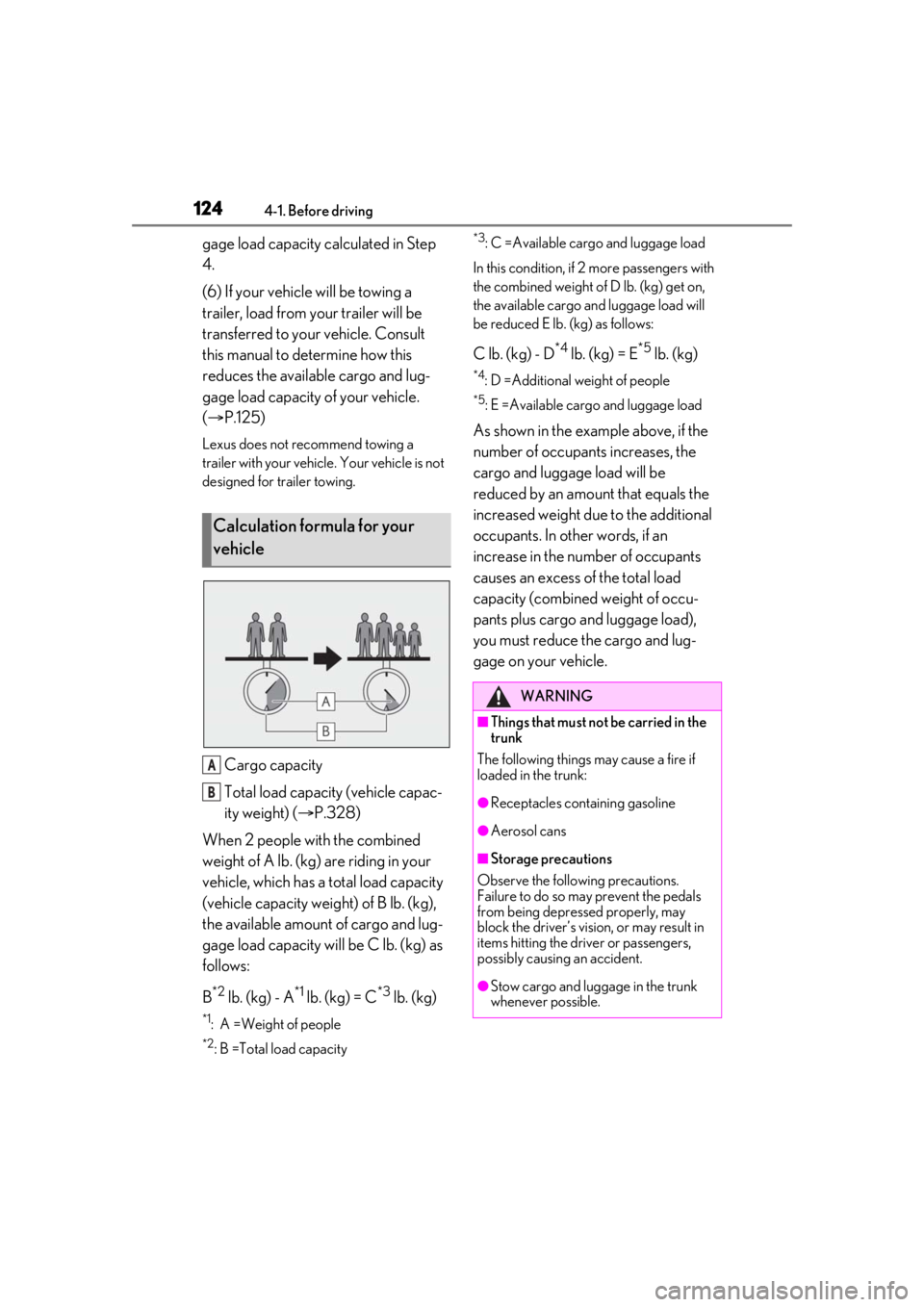
1244-1. Before driving
gage load capacity calculated in Step
4.
(6) If your vehicle will be towing a
trailer, load from your trailer will be
transferred to your vehicle. Consult
this manual to determine how this
reduces the available cargo and lug-
gage load capacity of your vehicle.
( P.125)
Lexus does not recommend towing a
trailer with your vehicle. Your vehicle is not
designed for trailer towing.
Cargo capacity
Total load capacity (vehicle capac-
ity weight) ( P.328)
When 2 people with the combined
weight of A lb. (kg) are riding in your
vehicle, which has a total load capacity
(vehicle capacity weight) of B lb. (kg),
the available amount of cargo and lug-
gage load capacity will be C lb. (kg) as
follows:
B
*2 lb. (kg) - A*1 lb. (kg) = C*3 lb. (kg)
*1: A =Weight of people
*2: B =Total load capacity
*3: C =Available cargo and luggage load
In this condition, if 2 more passengers with
the combined weight of D lb. (kg) get on,
the available cargo and luggage load will
be reduced E lb. (kg) as follows:
C lb. (kg) - D*4 lb. (kg) = E*5 lb. (kg)
*4: D =Additional weight of people
*5: E =Available cargo and luggage load
As shown in the example above, if the
number of occupant s increases, the
cargo and luggage load will be
reduced by an amount that equals the
increased weight due to the additional
occupants. In other words, if an
increase in the number of occupants
causes an excess of the total load
capacity (combined weight of occu-
pants plus cargo and luggage load),
you must reduce the cargo and lug-
gage on your vehicle.
Calculation formula for your
vehicle
A
B
WARNING
■Things that must not be carried in the
trunk
The following things may cause a fire if
loaded in the trunk:
●Receptacles containing gasoline
●Aerosol cans
■Storage precautions
Observe the following precautions.
Failure to do so may prevent the pedals
from being depressed properly, may
block the driver’s vision, or may result in
items hitting the driver or passengers,
possibly causing an accident.
●Stow cargo and luggage in the trunk
whenever possible.
Page 125 of 400
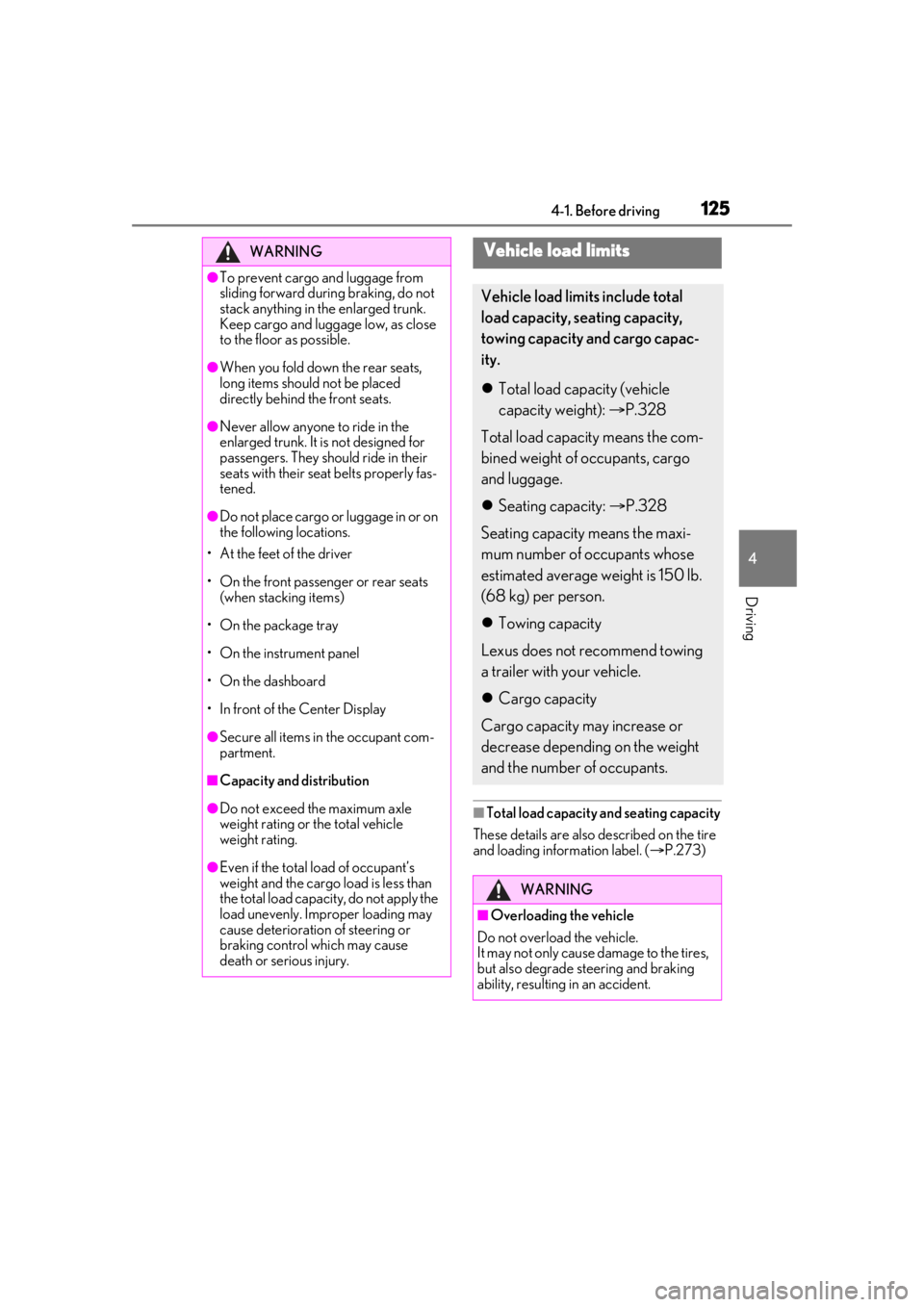
1254-1. Before driving
4
Driving
■Total load capacity and seating capacity
These details are also described on the tire
and loading information label. ( P.273)
WARNING
●To prevent cargo and luggage from
sliding forward during braking, do not
stack anything in th e enlarged trunk.
Keep cargo and luggage low, as close
to the floor as possible.
●When you fold down the rear seats,
long items should not be placed
directly behind the front seats.
●Never allow anyone to ride in the
enlarged trunk. It is not designed for
passengers. They should ride in their
seats with their seat belts properly fas-
tened.
●Do not place cargo or luggage in or on
the following locations.
• At the feet of the driver
• On the front passenger or rear seats (when stacking items)
• On the package tray
• On the instrument panel
•On the dashboard
• In front of the Center Display
●Secure all items in the occupant com-
partment.
■Capacity and distribution
●Do not exceed the maximum axle
weight rating or the total vehicle
weight rating.
●Even if the total load of occupant’s
weight and the cargo load is less than
the total load capacity, do not apply the
load unevenly. Improper loading may
cause deterioration of steering or
braking control which may cause
death or serious injury.
Vehicle load limits
Vehicle load limits include total
load capacity, seating capacity,
towing capacity and cargo capac-
ity.
Total load capacity (vehicle
capacity weight): P.328
Total load capacity means the com-
bined weight of occupants, cargo
and luggage.
Seating capacity: P.328
Seating capacity means the maxi-
mum number of occupants whose
estimated average weight is 150 lb.
(68 kg) per person.
Towing capacity
Lexus does not recommend towing
a trailer with your vehicle.
Cargo capacity
Cargo capacity may increase or
decrease depending on the weight
and the number of occupants.
WARNING
■Overloading the vehicle
Do not overload the vehicle.
It may not only cause damage to the tires,
but also degrade steering and braking
ability, resulting in an accident.
Page 126 of 400
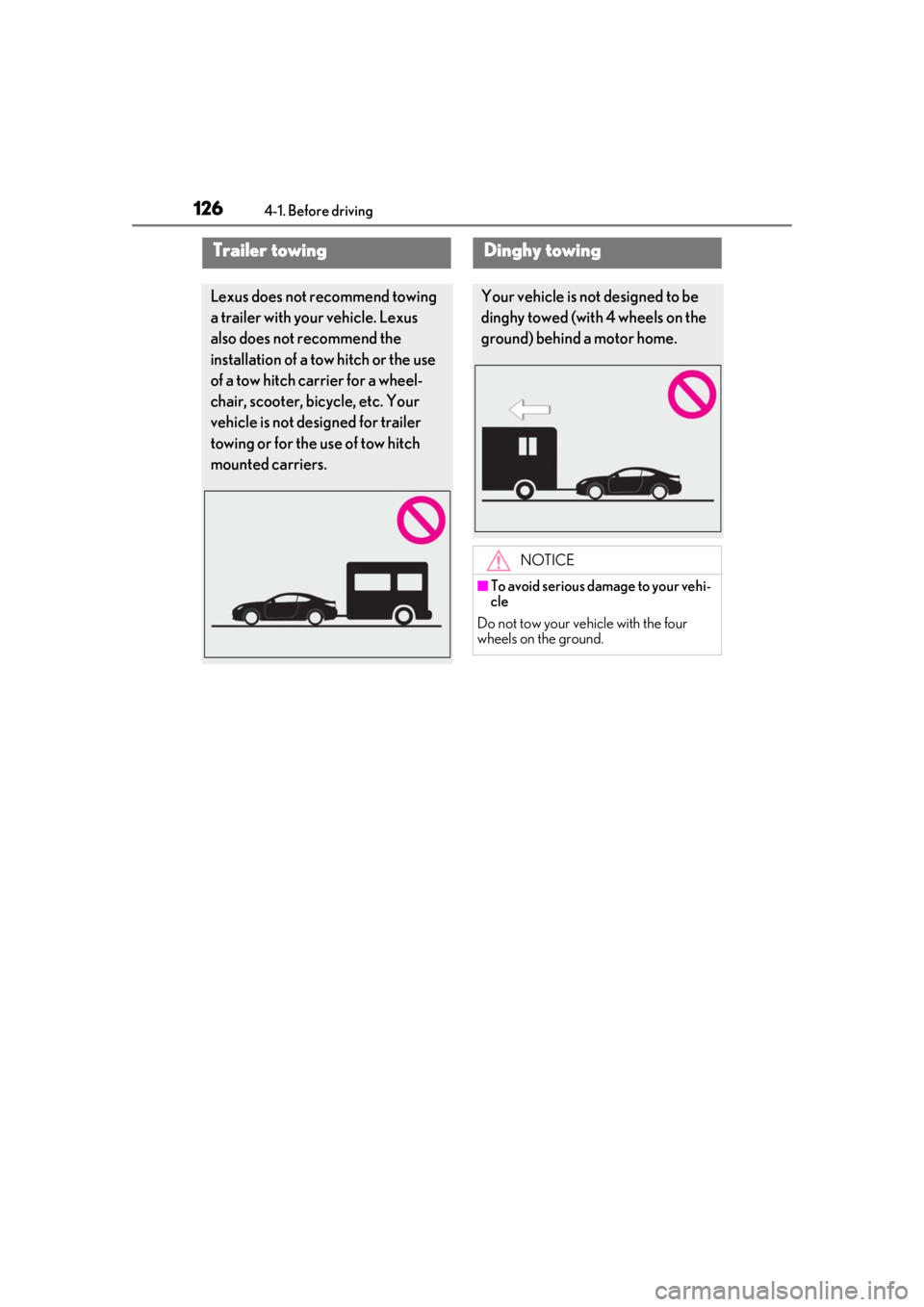
1264-1. Before driving
Trailer towing
Lexus does not recommend towing
a trailer with your vehicle. Lexus
also does not recommend the
installation of a tow hitch or the use
of a tow hitch carrier for a wheel-
chair, scooter, bicycle, etc. Your
vehicle is not designed for trailer
towing or for the use of tow hitch
mounted carriers.
Dinghy towing
Your vehicle is not designed to be
dinghy towed (with 4 wheels on the
ground) behind a motor home.
NOTICE
■To avoid serious damage to your vehi-
cle
Do not tow your vehicle with the four
wheels on the ground.
Page 146 of 400
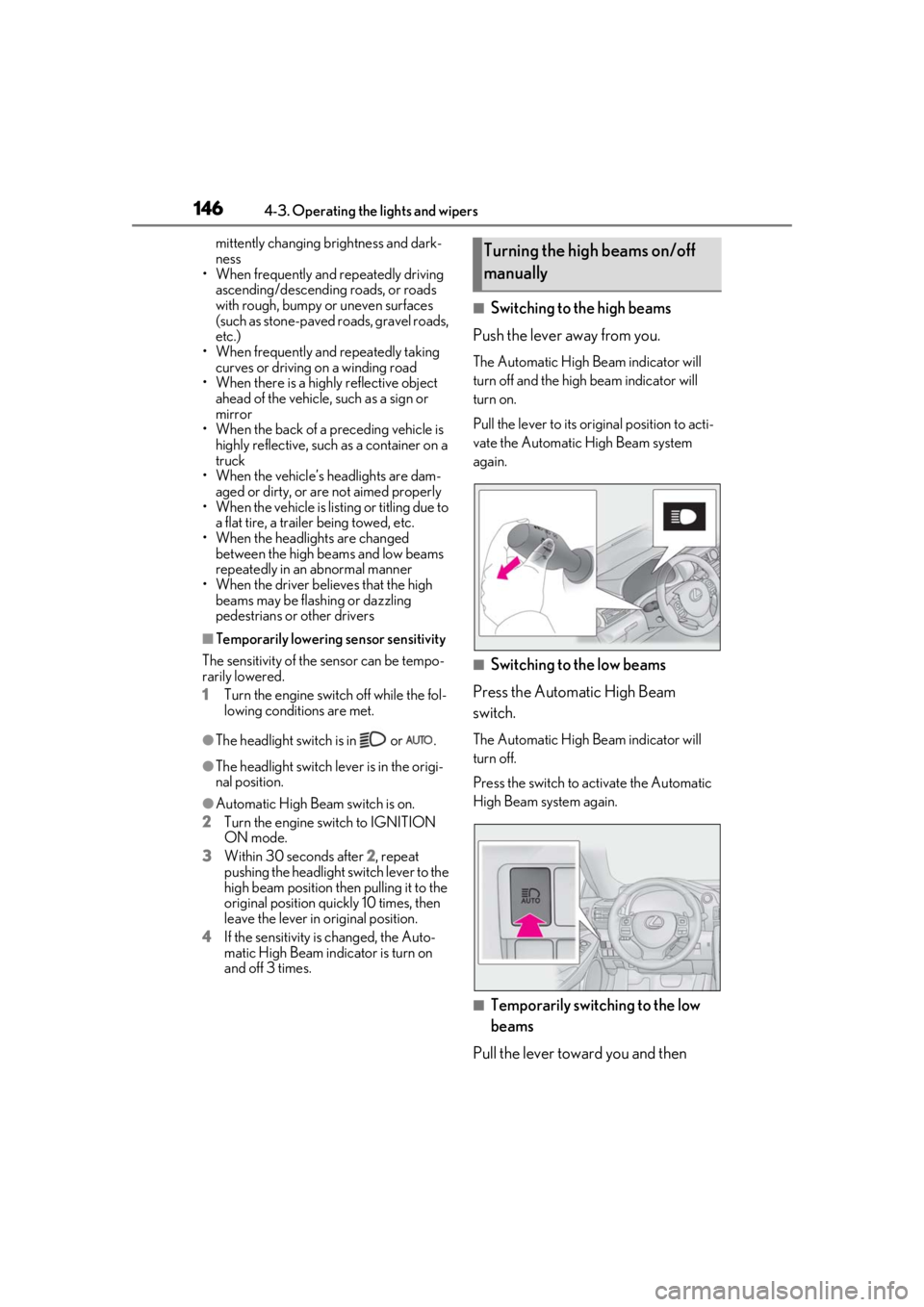
1464-3. Operating the lights and wipers
mittently changing brightness and dark-
ness
• When frequently and repeatedly driving
ascending/descending roads, or roads
with rough, bumpy or uneven surfaces
(such as stone-paved ro ads, gravel roads,
etc.)
• When frequently and repeatedly taking curves or driving on a winding road
• When there is a highly reflective object ahead of the vehicle, such as a sign or
mirror
• When the back of a preceding vehicle is highly reflective, such as a container on a
truck
• When the vehicle’s headlights are dam- aged or dirty, or are not aimed properly
• When the vehicle is listing or titling due to
a flat tire, a trailer being towed, etc.
• When the headlights are changed between the high beams and low beams
repeatedly in an abnormal manner
• When the driver believes that the high beams may be flashing or dazzling
pedestrians or other drivers
■Temporarily lowering sensor sensitivity
The sensitivity of the sensor can be tempo-
rarily lowered.
1 Turn the engine switch off while the fol-
lowing conditions are met.
●The headlight switch is in or .
●The headlight switch le ver is in the origi-
nal position.
●Automatic High Beam switch is on.
2 Turn the engine switch to IGNITION
ON mode.
3 Within 30 seconds after 2, repeat
pushing the headlight switch lever to the
high beam position then pulling it to the
original position quickly 10 times, then
leave the lever in original position.
4 If the sensitivity is changed, the Auto-
matic High Beam indicator is turn on
and off 3 times.
■Switching to the high beams
Push the lever away from you.
The Automatic High Beam indicator will
turn off and the high beam indicator will
turn on.
Pull the lever to its original position to acti-
vate the Automatic High Beam system
again.
■Switching to the low beams
Press the Automatic High Beam
switch.
The Automatic High Beam indicator will
turn off.
Press the switch to activate the Automatic
High Beam system again.
■Temporarily switching to the low
beams
Pull the lever toward you and then
Turning the high beams on/off
manually
Page 167 of 400
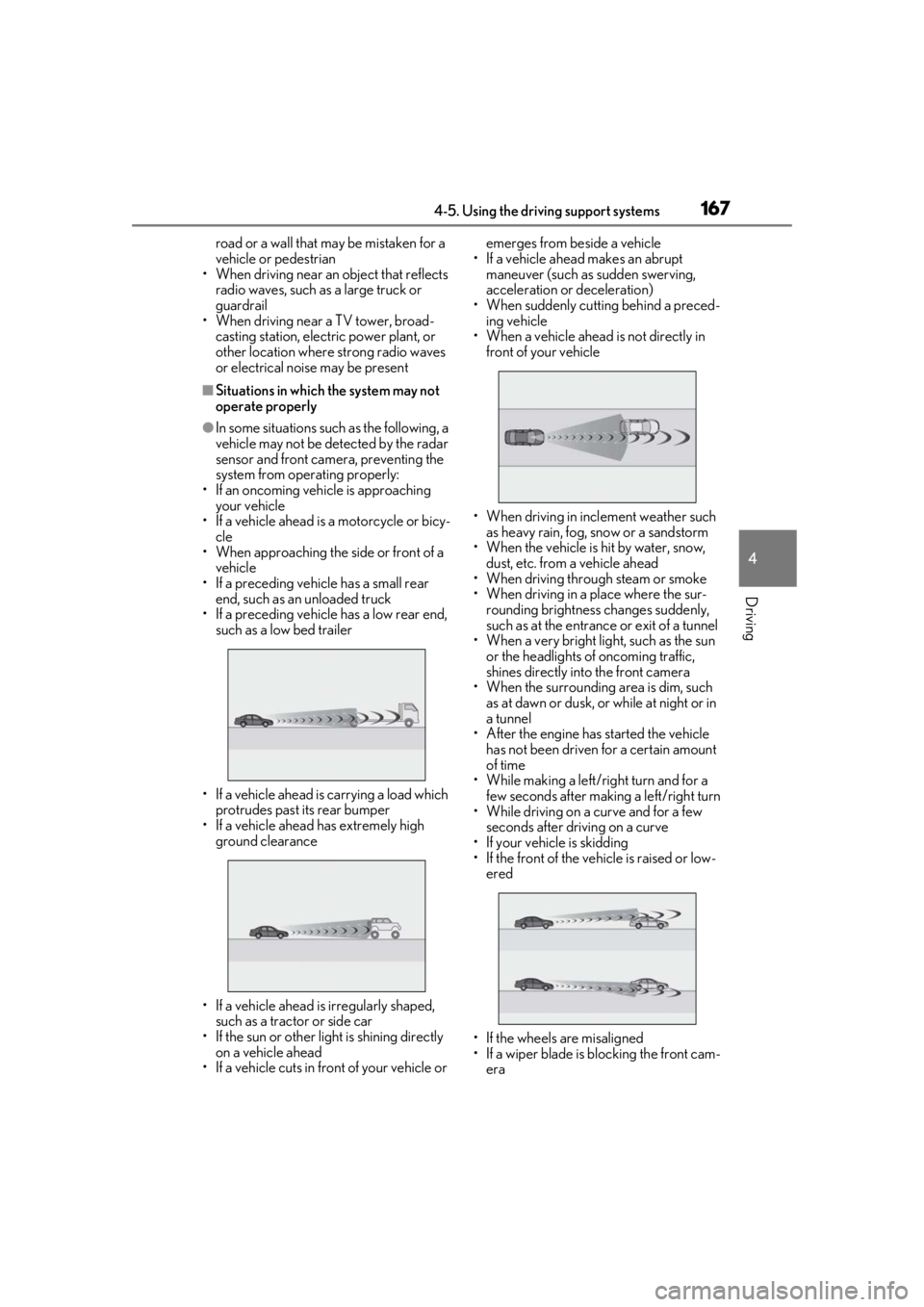
1674-5. Using the driving support systems
4
Driving
road or a wall that may be mistaken for a
vehicle or pedestrian
• When driving near an object that reflects
radio waves, such as a large truck or
guardrail
• When driving near a TV tower, broad-
casting station, electric power plant, or
other location where strong radio waves
or electrical noise may be present
■Situations in which the system may not
operate properly
●In some situations such as the following, a
vehicle may not be detected by the radar
sensor and front camera, preventing the
system from operating properly:
• If an oncoming vehicle is approaching your vehicle
• If a vehicle ahead is a motorcycle or bicy-
cle
• When approaching the side or front of a vehicle
• If a preceding vehicle has a small rear end, such as an unloaded truck
• If a preceding vehicle has a low rear end,
such as a low bed trailer
• If a vehicle ahead is carrying a load which protrudes past its rear bumper
• If a vehicle ahead has extremely high ground clearance
• If a vehicle ahead is irregularly shaped, such as a tractor or side car
• If the sun or other light is shining directly
on a vehicle ahead
• If a vehicle cuts in front of your vehicle or emerges from beside a vehicle
• If a vehicle ahead makes an abrupt maneuver (such as sudden swerving,
acceleration or deceleration)
• When suddenly cutting behind a preced- ing vehicle
• When a vehicle ahead is not directly in front of your vehicle
• When driving in incl ement weather such
as heavy rain, fog, snow or a sandstorm
• When the vehicle is hit by water, snow,
dust, etc. from a vehicle ahead
• When driving through steam or smoke
• When driving in a place where the sur- rounding brightness changes suddenly,
such as at the entrance or exit of a tunnel
• When a very bright light, such as the sun
or the headlights of oncoming traffic,
shines directly into the front camera
• When the surrounding area is dim, such
as at dawn or dusk, or while at night or in
a tunnel
• After the engine has started the vehicle
has not been driven for a certain amount
of time
• While making a left/right turn and for a
few seconds after making a left/right turn
• While driving on a curve and for a few seconds after driving on a curve
• If your vehicle is skidding
• If the front of the vehicle is raised or low- ered
• If the wheels are misaligned
• If a wiper blade is blocking the front cam- era
Page 184 of 400
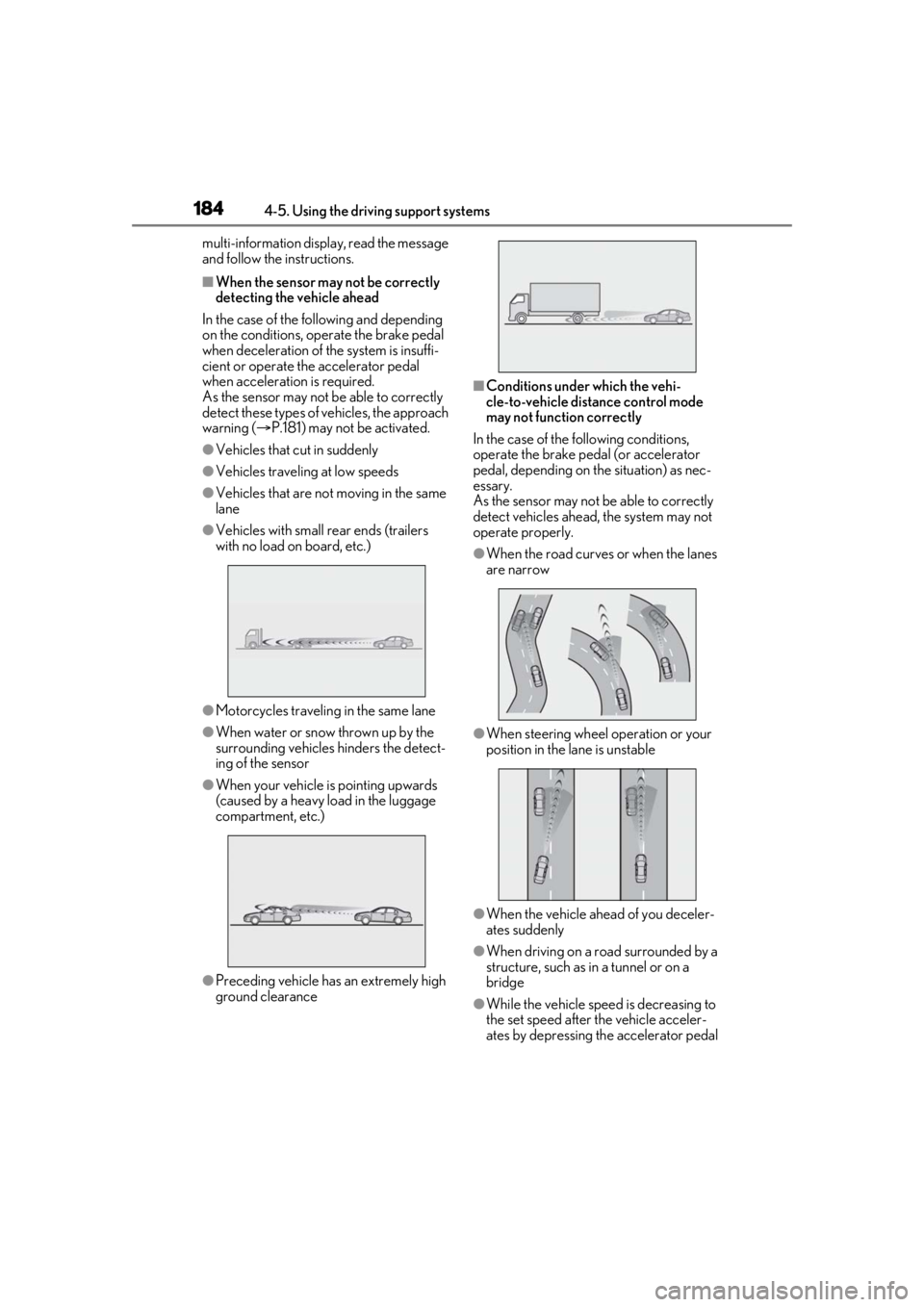
1844-5. Using the driving support systems
multi-information display, read the message
and follow the instructions.
■When the sensor may not be correctly
detecting the vehicle ahead
In the case of the following and depending
on the conditions, operate the brake pedal
when deceleration of the system is insuffi-
cient or operate the accelerator pedal
when acceleration is required.
As the sensor may not be able to correctly
detect these types of vehicles, the approach
warning ( P.181) may not be activated.
●Vehicles that cut in suddenly
●Vehicles traveling at low speeds
●Vehicles that are not moving in the same
lane
●Vehicles with small rear ends (trailers
with no load on board, etc.)
●Motorcycles travelin g in the same lane
●When water or snow thrown up by the
surrounding vehicles hinders the detect-
ing of the sensor
●When your vehicle is pointing upwards
(caused by a heavy load in the luggage
compartment, etc.)
●Preceding vehicle has an extremely high
ground clearance
■Conditions under which the vehi-
cle-to-vehicle distance control mode
may not function correctly
In the case of the following conditions,
operate the brake pedal (or accelerator
pedal, depending on the situation) as nec-
essary.
As the sensor may not be able to correctly
detect vehicles ahead, the system may not
operate properly.
●When the road curves or when the lanes
are narrow
●When steering wheel operation or your
position in the lane is unstable
●When the vehicle ahead of you deceler-
ates suddenly
●When driving on a road surrounded by a
structure, such as in a tunnel or on a
bridge
●While the vehicle speed is decreasing to
the set speed after the vehicle acceler-
ates by depressing the accelerator pedal
Page 394 of 400

394Alphabetical Index
Outside rear view mirror switches ...... 110
Paddle shift switches ....................... 133, 134
Parking brake switch ................................. 137
PCS OFF switch ..........................................164
Power door lock switch ............................ 90
Power window switches ............................112
Rear window and outside rear view mir-ror defoggers switch ..............................215
Seat heater switches ................................ 223
Seat ventilator switches .......................... 223
Snow mode switch .....................................133
“SOS” button .................................................. 52
Tilt and telescopic steering control switch .......................................................................... 108
Tire pressure warning reset switch .. 270
Trunk opener main switch ....................... 94
Trunk opener switch ................................... 92
VSC OFF switch ....................................... 202
Window lock switch ................................... 113
Windshield wiper and washer switch147
Windshield wiper de-icer switch ........ 219
T
Tachometer....................................................... 66 Rev indicator ................................................... 69
Rev peak ........................................................... 69
Tail lights Light switch ..................................................... 142
Replacing light bulbs................................ 282
Wattage..........................................................338
Theft deterrent system Alarm .................................................................. 57
Engine immobilizer system ..................... 56
Theft prevention labels............................... 59
Tire inflation pressure Maintenance data...................................... 334
Tire inflation pressu re display function
.........................................................................268
Warning light .............................................. 300
Tire information ..............................................341 Glossary......................................................... 345
Size.................................................................... 343 Tire identification number...................... 342
Uniform Tire Quality Grading ............344
Tire infration pressure .................................. 75
Tire pressure display ... ............................... 268
Tire pressure warning system Function ......................................................... 268
Initializing........................................................269
Installing tire pres sure warning valves
and transmitters.......................................269
Registering ID codes ................................. 271
Warning light .............................................. 300
Tires Chains ............................................................ 206
Checking .......................................................265
If you have a flat tire ..................................307
Inflation pressure ........................................ 273
Information ......................................................341
Replacing .......................................................307
Rotating tires ................................................ 267
Size ....................................................................334
Snow tires ..................................................... 205
Spare tire ........................................................307
Tire inflation pressure display function......................................................................... 268
Tire pressure warning system ............ 268
Warning light .............................................. 300
Tools.................................................................. 307
Top tether strap.........................................41, 49
Total load capacity ...................................... 328
Towing Dinghy towing ...............................................126
Emergency towing................................... 289
Towing eyelet.................................................291
Trailer towing .................................................126
TRAC (Traction Control) ..........................201
Traction Control (TRAC) ..........................201
Trailer towing ..................................................126
Transmission Automatic transmission ............................. 131
Driving mode select switch ................... 199
M mode ............................................................134
Paddle shift switches ....................... 133, 134